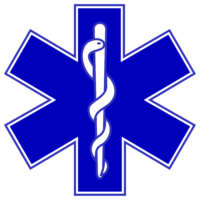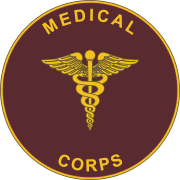When you want an icon that refers to medicine, use the rod with one snake, called the Rod of Asclepius. For commerce (and some other things, see below) use the winged staff with two snakes, called the Caduceus. These two symbols have very different meanings!

Rod of Asclepius, Medicine
The Rod of Asclepius (displayed to the left) is the symbol for the Greco-Roman god Asclepius, known for his connection with medicine. It is a rod with one snake. The symbol is used today to represent the medical profession. You can commonly find this symbol on ambulances and everywhere medical symbols or logos are needed.

Caduceus, Commerce
The Caduceus (displayed to the right) is the symbol for the Greco-Roman god Hermes or Mercury. It is a staff with two snakes and wings. Hermes is known for being a messenger of the gods, protector of merchants, guide to the dead, shepherds, gamblers, liars, and thieves. The Caduceus is generally used today as a symbol of commerce.
Why is there confusion in the U.S.?
In 1902 the US Army Medical Corp chose the Caduceus as their insignia. Most scholars regard this as a flat-out mistake. The US Army writes that the Caduceus “symbolizes the non-combatant role of the AMEDD”, which is to say they fully admit they are not using it as a medical symbol.
Here is the full text, retrieved from the US Army website on 12-10-24 (and on their 2011-2021 site):
Why does the Army Medical Department use the Caduceus, which represents the Greek god Hermes and the Roman god Mercury, instead of the Staff of Asclepius, the Greek god of healing?
The Army Medical Department uses both the Caduceus (Mercury’s/Hermes’ Staff) and the Staff of Asclepius as symbols for the Army Medical Department (AMEDD). The Staff of Asclepius, or Aesculapius, symbolizes the medical mission of the AMEDD, and is included on the AMEDD Regimental Crest (the staff with one snake entwined around it). The Caduceus, two snakes around a winged staff, symbolizes the non-combatant role of the AMEDD. The Caduceus was first used on enlisted men`s uniforms in 1851, over a decade before the establishment of the Red Cross as a symbol of non-combatants. In 1902 the Caduceus was chosen to replace the Maltese Cross insignia on Medical Corps officers` collars. In 1907, the Army Nurse Corps – the only other officer corps in the AMEDD at that time – began wearing a Caduceus with the letters ANC superimposed over it. Since that time, all new officer corps have been represented by a Caduceus specific to their corps, worn on the collars of their officers. After the First World War, many medical professionals left the army and returned to civilian practice. When they did, they took with them the Caducei they had worn proudly as members of the Army Medical Department. Over time, the Caduceus became associated with medicine in America, even in medical practices that had no association with the Army. Originally, though, the Caduceus did not stand for medicine, but represented the non-combatant status of military medicine on the battlefield.
The Encyclopedia Britannica notes, “Among the ancient Greeks and Romans [the Caduceus] became the badge of heralds and ambassadors, signifying their inviolability.” So maybe the US Army was thinking the symbol would convey a sense of “… Hey, hey, hey, don’t kill me, I’m just a messenger delivering the wounded to the hospital!” or some such. That is quite a stretch; I think somebody just used the wrong symbol. Today, military ambulances use the red cross and and civilian ambulances use the Star of Life, which prominently features, you guessed it, the Rod of Asclepius.
So why shouldn’t a medical provider use the Caduceus? Oh, let me count the ways! Being the symbol of Hermes, at best, it implies the medical professional is either selling or delivering something. The closest you’ll ever get to it being the right symbol is for a palliative care setting where medical professionals carefully “transport” those in their care into the afterlife. It goes downhill from there; it may imply the medical provider will kill you (Hermes is the guide to the dead!), feed you to the dogs (shepherds!), hock your jewelry (gamblers!), and tell your mom they haven’t seen you in a week (liars and thieves!). It is generally not a reassuring medical symbol. If you are a medical provider, please do not use the Caduceus!
-

-
The Rod of Asclepius, a medical symbol
-

-
The Caduceus, a commerce symbol
-

-
The Star of Life, a medical symbol
-

-
The US Army Medical Corps Insignia
-

-
Rod of Asclepius 2018 redesign by the United Nations
Academic research on the subject is very clear. The Caduceus is not a medical symbol, the Rod of Asclepius is.  The best research can be found in the 1992 book The Golden Wand of Medicine a History of the Caduceus Symbol in Medicine by Walter Friedlander
The best research can be found in the 1992 book The Golden Wand of Medicine a History of the Caduceus Symbol in Medicine by Walter Friedlander
Dr. Friedlander spends 181 pages meticulously reviewing the history of the two symbols from their origins to the present day. It is very well researched, with lengthy bibliographies. He nails down with all the certainty that can be mustered by the best academician that the Caduceus is the wrong symbol to represent medicine. Read the final sentences of the book read (bold is mine):
It seems most likely that the caduceus became associated with medicine because of two errors: confusion of Traditional Hermes with other Hermes, and lack of recognizing or knowing the difference between two distinct serpentine objects, Traditional Hermes’ caduceus and Aesculapius’ staff. The result is that present day medicine, particularly in the United States, often shares the same symbol with merchants and commerce. Although, unfortunately, many lay people may think this is appropriate, it seems unlikely that most medical people, if they understood the underlying meaning of this object, would find it suitable. – page 158
Here are some scans of the first page and the concluding pages of The Golden Wand of Medicine.
There are a plethora of other resources I welcome you to explore. They all say the same thing. “Use the rod of Asclepius as the medical symbol”. Here’s a few articles from highly regarded sources to get you started:
- Finn, R., Orlans,D. A., Davenport, G. (1999). A much misunderstood caduceus and the case for an aesculapion. The Lancet, 353 (9168), 1978. http://dx.doi.org/10.1016/S0140-6736(05)77199-3
- Wilcox, R. A., & Whitham, E. M. (2003). The Symbol of Modern Medicine: Why One Snake Is More Than Two. Annals Of Internal Medicine, 138(8), 673. http://www.ncbi.nlm.nih.gov/pubmed/12693891
- Things you don’t learn in medical school: Caduceus http://www.ncbi.nlm.nih.gov/pmc/articles/PMC4439707/
- Wikipedia has a trove of well referenced info about the subject: Caduceus as a symbol of medicine, Caduceus, Rod of Asclepius, pictures of Ambulances, etc…
- Realizing the mistake, Monmouth University Nursing School removes the Caduceus from their logo in 2018
- Encyclopedia Britannica entries for Caduceus, Hermes, the Rod of Asclepius, and Asclepius.
————————————————–
Here is the full text from the US Army Medical Department Office of Medical History Frequently Asked Questions page, retrieved 10-31-20: (bold is mine)
Why does the Army Medical Department use the Caduceus, which represents the Greek god Hermes and the Roman god Mercury, instead of the Staff of Asclepius, the Greek god of healing?
The Army Medical Department uses both the Caduceus (Mercury’s/Hermes’ Staff) and the Staff of Asclepius as symbols for the Army Medical Department (AMEDD). The Staff of Asclepius, or Aesculapius, symbolizes the medical mission of the AMEDD, and is included on the AMEDD Regimental Crest (the staff with one snake entwined around it). The Caduceus, two snakes around a winged staff, symbolizes the non-combatant role of the AMEDD. The Caduceus was first used on enlisted men’s uniforms in 1851, over a decade before the establishment of the Red Cross as a symbol of non-combatants. In 1902 the Caduceus was chosen to replace the Maltese Cross insignia on Medical Corps officers’ collars. In 1907, the Army Nurse Corps – the only other officer corps in the AMEDD at that time – began wearing a Caduceus with the letters ANC superimposed over it. Since that time, all new officer corps have been represented by a Caduceus specific to their corps, worn on the collars of their officers. After the First World War, many medical professionals left the army and returned to civilian practice. When they did, they took with them the Caducei they had worn proudly as members of the Army Medical Department. Over time, the Caduceus became associated with medicine in America, even in medical practices that had no association with the Army. Originally, though, the Caduceus did not stand for medicine, but represented the non-combatant status of military medicine on the battlefield.
————————————————–
Notes:
“Asclepius” is also spelled Asclepios or (Latin) Aesculapius
The Rod of Asclepius image above was created by David Khai, distributed by The Noun Project. The fine folks at the Noun Project were a great help when I brought this issue to them, fixing hundreds of their catalog listings appropriately! Thank you!










